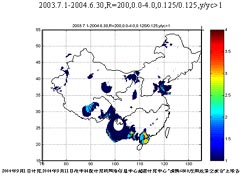
With a supercomputer at CAS and a model developed by Chinese scientists, a research group led by Prof. Yin Xiangchu, a guest researcher at the State Key Lab of Nonlinear Mechanics affiliated to the CAS Institute of Mechanics, correctly predicted an earthquake in south China on Sept. 11, six days before it occurred.
The prediction comes from a spatial scanning on Sept 1 over the Chinese mainland with Load/Unload Response Ratio (LURR), an earthquake prediction method put forward about 20 years ago by Prof. Yin, a researcher at the Analysis and Forecast Center of China Seismological Bureau (CSB).
By using DeepComp 6800, a supercomputer at the CAS Computer Network and Information Center (CNIC), the researchers completed the scanning with radii of the scan space window of 100, 200, 300 and 400km respectively and the scan step just of 0.125 degrees. It took the supercomputer less than four hours to get the results, which would take PCs at least one week.
From the abnormal areas shown fro the scanning, researchers found the Yangjiang region in south China's Guangdong Province was the most unusual and sent their report to CSB. They also released the prediction at the "a Briefing Meeting on the DeepComp 6800 Application Results" on Sept. 11, 2004. Six days later, at 2:13 AM on September 17, an earthquake with a magnitude of 4.9 on the Richter scale hit the region.
The forecasting was efficacious and accurate that its predicted values on the three essential factors of an earthquake, namely, the earthquake's time, location and strength, all tallied the actual ones (the predicted magnitude was 5-6 on the Richter scale, while the actual figure practically measured from the seismic event was 4.9. The deviation error of 0.1 is within the accepted tolerance).
The prediction is hailed as one of important application achievements of the DeepComp 6800, a brainchild independently developed by the Levovo Corp. Group and now working at CNIOC. It ranked the 14th with a sustained performance of 4.183 TFlops and the peak computing speed at 5.3 TFlops in the latest top 500 supercomputers list released by the Lawrence Berkeley National Laboratory on November 16, 2003.







